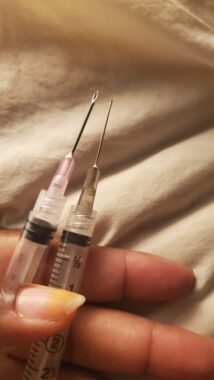Living with lupus entails a never-ending learning curve
I had to learn everything there is to know about needles
Written by |

It seems like there should be some decisions a person never has to make for themself.
Standing before the consultation window at the pharmacy, I found myself faced with a question that made me wonder: Is this a real question? Am I supposed to know the answer to this, too? Why didn’t the prescribing doctor decide? What’s the best option?
The pharmacist had asked which needle I needed for a new prescription. Apparently, I was supposed to decide, and it wasn’t a decision I was prepared for or knowledgeable enough about to make at that time. Like many of these moments, time seemed to slow down.
That moment was heavier than it should’ve been. In fact, it underscored how some decisions can be burdensome when living with lupus. Like so much of this journey of adapting to the unexpected, decisions like which needle size you need in order to self-administer injections, give blood for testing, or receive infusions do not fit in the “information-I-want-to-know” compartment of your brain.
Well, my dearies, here is another thing lupus teaches: the vast world of medical needles.

Candace J Semien
Candace Semien demonstrates the difference between an 18-gauge needle, left, and a 27-gauge needle. (Photo by Candace Semien)
Medical needles vary in type, based on their application, ranging from hypodermic needles for injections to specialized needles for procedures like biopsies and spinal taps. Hypodermic needles, the most common type, are categorized by gauge and length, and are used for injections into the skin (intradermal), under the skin (subcutaneous), or into muscle (intramuscular).
A quick search on the internet reveals an endless list of medical needles: biopsy needles, butterfly needles, drawing needles, gauge needles, hypodermic needles, insulin syringes, intravenous needles, irrigation syringes, safety syringes, spinal needles, straight needles, tuberculin syringes, vacutainer needles, and more.
If all that new information triggered an immediate sigh and an eye roll, then you and I can be forever allies. As with so much of this chronic illness journey, we are learning and adapting as we go.
My first experience with needle sizes occurred during my worst lupus flares, when I was suffering most. A fatigued vein hidden beneath inflamed skin prevented nurses from drawing blood and hindered the flow of IVs and infusions. My family and I had a series of very difficult conversations about implanting a port in my chest under the top layer of skin, which would allow for easier access to veins and quicker administration of medicines in critical moments when disease activity was severe. To others, having the port inserted in me was more than plausible; it was critical.
I felt differently and declined — several times. Today, I’m happy with that choice, which was one more thought-through decision that I celebrate. Since then, my veins have strengthened and my skin has softened.
The trial and error of multiple painful and ineffective pokes made me learn which needles were the best for me — especially during painful crises. I learned that my veins mostly accept a butterfly hypodermic needle in medical settings and a 22-gauge or 27-gauge needle for self-injections.
This knowledge gave me a voice for speaking up to receive the right device that makes the blood-drawing and IV-infusing processes much smoother. It also helps whenever the pharmacy forgets to add needles and I have to specify the gauge and color of the needle I desire.
We may not know why there frequently seems to be something new to learn or even just accept about living with lupus, so we take a deep breath and learn the new things in earnest.
We will always be actively learning how to maneuver life within the different abilities impacted by lupus. The more we learn these new things, the better we can make a decision, add it to our medical notes, and move on to manage the stress of it so that we maintain some semblance of control and ownership of our wellness — which is the ultimate goal.
Note: Lupus News Today is strictly a news and information website about the disease. It does not provide medical advice, diagnosis, or treatment. This content is not intended to be a substitute for professional medical advice, diagnosis, or treatment. Always seek the advice of your physician or other qualified health provider with any questions you may have regarding a medical condition. Never disregard professional medical advice or delay in seeking it because of something you have read on this website. The opinions expressed in this column are not those of Lupus News Today or its parent company, Bionews, and are intended to spark discussion about issues pertaining to lupus.





Leave a comment
Fill in the required fields to post. Your email address will not be published.